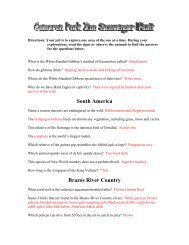New World Vultures vs. Old World Vultures - Cameron Park Zoo
New World Vultures vs. Old World Vultures - Cameron Park Zoo
New World Vultures vs. Old World Vultures - Cameron Park Zoo
You also want an ePaper? Increase the reach of your titles
YUMPU automatically turns print PDFs into web optimized ePapers that Google loves.
No matter how vultures are perceived, they do coexist with us, and they have an important<br />
place in our society, our culture, and most importantly in our natural environment.<br />
We have learned that other cultures have revered vultures in their artwork and legends of the<br />
past. Early hunter-gatherers of many cultures knew to follow the signs of circling vultures in<br />
order to find dead and dying animals for a free meal. We know that there are cultures today<br />
who rely on vultures to dispose of their dead, both human and livestock.<br />
We rely on vultures to help keep our drinking water and soil safe from harmful bacteria that<br />
would build up without their efforts. <strong>Vultures</strong> also help remove human made waste that would<br />
take up space and spread disease.<br />
We can admire the vulture as a symbol of energy efficiency in flight. Their large wingspans and<br />
use of thermals for ascending in the air have long been studied, admired, and imitated in the<br />
use of aerodynamics. They can ride thermals for long periods of time, hardly ever having to<br />
beat their wings to stay aloft. In this way, they can cover large areas in search of food.<br />
Mankind has also learned to make use of the keen nose of the turkey vulture. Natural gas has<br />
no odor, so a substance called ethyl mercaptan is added to it. This odor closely resembles the<br />
odor that is given off by decaying flesh, so natural gas employees can use large congregations of<br />
vultures to help locate breaks or leaks in natural gas lines.<br />
Vulture populations have suffered from habitat destruction, chemical poisoning, and poaching<br />
at the hands of mankind. We have worked hard to bring back populations that have been<br />
brought to the edge of extinction, and we have had some success. We need to realize how our<br />
actions affect other species, and continue to find ways to fix the problems we have unwittingly<br />
caused.<br />
Many people would prefer to think that they have nothing in common with vultures. In truth,<br />
mankind shares a kinship with living creatures on the planet, and the more we understand<br />
them, the more we can strive to live together in peace.<br />
Vulture Culture<br />
In our modern culture, vultures are often associated with death, desolation,<br />
and darkness. <strong>Vultures</strong> are often depicted in deserts and other remote<br />
locations, even though they are found in all kinds of habitats throughout the<br />
world. They are also used as spooky decorations at Halloween and used in<br />
phrases to depict the finality of things, such as “the vultures are circling”.<br />
People who prey on the weaknesses of others are considered vultures.<br />
Ancient Egyptians had a hieroglyph in their language of the vulture. This hieroglyph<br />
was used to say words such as mother, prosperous, grandmother, and<br />
ruler. The vulture was held sacred to the goddess Isis, and was viewed<br />
as a symbol of royalty.



